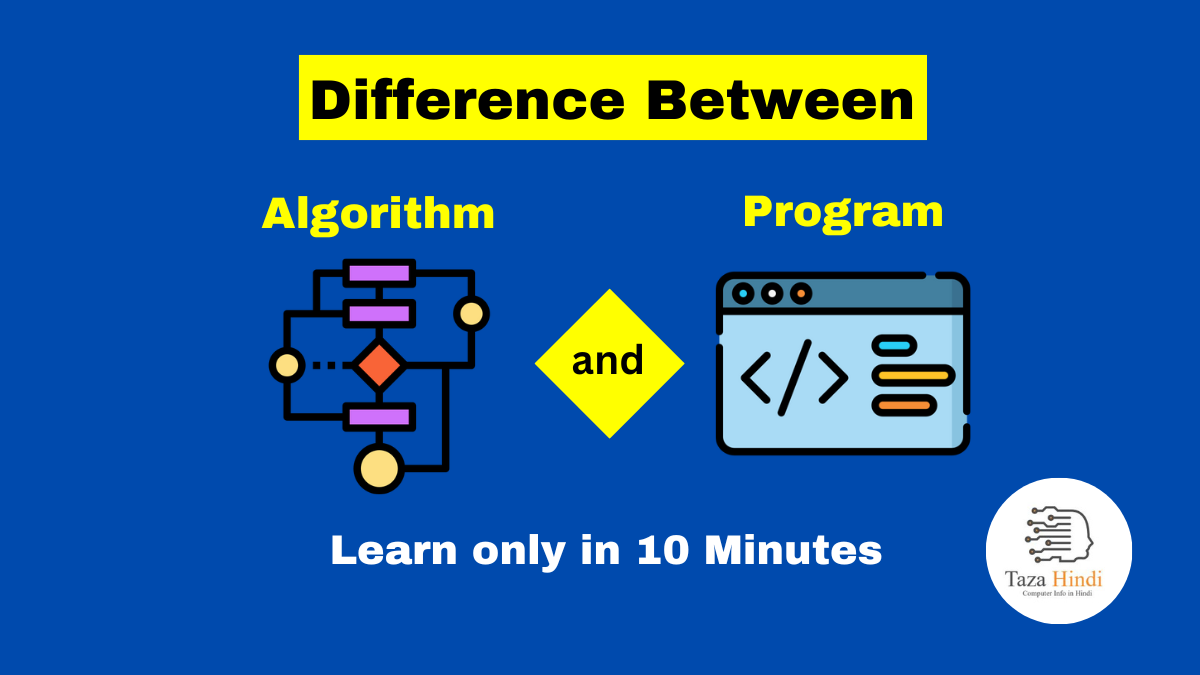In the world of computer science and software development, the terms “algorithm” and “program” are often used interchangeably. However, they represent distinct concepts with unique characteristics, purposes, and functionalities. In this article, you will get information about what is an Algorithm and Program, their characteristics, purposes, functionalities, applications and then explore the what are the difference between algorithm and program. So let’s delve into the world of algorithms and programs.
What is an Algorithm?
Characteristics of Algorithm
- Precise and unambiguous instructions
- Finiteness, meaning it must terminate after a finite number of steps
- Determinism, yielding the same result for the same input
- Input and output
- Repetition and control structures
Purpose of an Algorithm
The main purpose of an algorithm is to solve problems or perform tasks effectively and efficiently. Algorithms are essential in various fields, including mathematics, computer science, data analysis, and optimization. They play a crucial role in developing complex systems and optimizing processes.
Also Read : Difference between Static and Dynamic Memory Allocation
Functionality of Algorithm
An algorithm provides a clear set of instructions that outline the necessary steps to accomplish a task. It can manipulate data, perform calculations, make decisions, and control the flow of execution. Algorithms act as blueprints for programs and help translate problem-solving logic into executable code.
Examples of Algorithm
- Sorting algorithms (e.g., bubble sort, quicksort)
- Searching algorithms (e.g., binary search)
- Pathfinding algorithms (e.g., Dijkstra’s algorithm)
- Encryption algorithms (e.g., RSA algorithm)
- Machine learning algorithms (e.g., linear regression, neural networks)
Applications of Algorithm
Algorithms have widespread applications in various fields:
- Data analysis and processing
- Image and signal processing
- Computational biology and genetics
- Network optimization and routing
- Artificial intelligence and machine learning
What is a Program?
Characteristics of Program
- Written in a programming language
- Translated into machine code or executed by an interpreter
- Contains variables, functions, and control structures
- May interact with the user or other systems
- May include user interfaces and graphical elements
Also Read : Difference between Class and Structure
Purpose of a Program
The purpose of a program is to enable a computer to perform specific tasks or solve problems by executing a set of instructions. Programs provide the necessary functionality to achieve desired outcomes, such as processing data, performing calculations, interacting with users, and controlling hardware devices.
Functionality of a Program
A program executes the instructions defined by the algorithm it implements. It can handle input and output operations, store and manipulate data, control the flow of execution, and interact with external resources or devices. Programs can be simple scripts or complex software applications.
Examples of Programs
- Word processors (e.g., Microsoft Word, Google Docs)
- Web browsers (e.g., Google Chrome, Mozilla Firefox)
- Video games (e.g., Minecraft, FIFA)
- Operating systems (e.g., Windows, macOS, Linux)
- Image editing software (e.g., Adobe Photoshop, GIMP)
Also Read : Top 10 Certifications in Computer Science for High Salary in 2023
Relationship between Algorithm and Program
An algorithm is an abstract concept, while a program is a concrete implementation of that algorithm. A program is the manifestation of an algorithm in a specific programming language, with syntax and structure tailored to the language’s requirements. In other words, an algorithm provides the logic, and a program provides the execution.
Difference between Algorithm and Program
| Algorithm | Program |
| An algorithm is an abstract concept, independent of any programming language or platform. | While a program is a concrete implementation of an algorithm using a specific programming language. |
| Algorithms are high-level and focus on the logic and steps required to solve a problem. | Programs are low-level and provide detailed instructions, including syntax, data types, and control structures. |
| Algorithms are not directly executable by a computer. They serve as a blueprint for programs. | Programs are directly executable by a computer, as they are translated into machine code or interpreted by a runtime environment. |
| Algorithms are language-agnostic and can be implemented in various programming languages. | Programs, once implemented, are bound to a specific programming language and may require modifications to port to another language. |
| Algorithms can be generic and applicable to a broad class of problems. | Programs are specific to particular tasks or problems and provide detailed instructions to accomplish those tasks. |
Also Read : What is Moonlighting, Pros and Cons of Moonlighting
Conclusion
Algorithms and programs are distinct concepts in computer science. Algorithms serve as problem-solving strategies, providing a logical sequence of steps, while programs are concrete implementations of those algorithms in a specific programming language. Understanding the differences between algorithms and programs is essential for developing efficient and effective software solutions.
FAQs
-
Can an algorithm exist without a program?
Yes, an algorithm can exist independently of a program. Algorithms are abstract concepts that can be represented in various ways, such as natural language descriptions or pseudocode, without being tied to a specific programming language or implementation.
-
Are all programs based on algorithms?
Yes, all programs are based on underlying algorithms. Programs translate the logical steps and instructions provided by algorithms into executable code that a computer can understand and execute.
-
Can a program have multiple algorithms?
Yes, programs can incorporate multiple algorithms to solve complex problems or perform various tasks. Programs can consist of multiple functions or modules, each implementing a specific algorithm to achieve a specific functionality within the overall program.
-
Can a program be considered an algorithm?
No, a program cannot be considered an algorithm.
